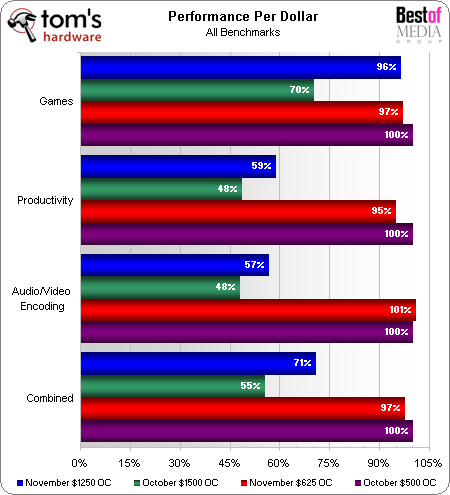System Builder Marathon: Performance & Value
“Bang for the Buck” Conclusion

We used the cheapest system from today’s charts as the basis for comparing the performance advantages of “spending up.”

At 2.5 times the price of the cheapest system, our new $1,250 enthusiast-level build shines with 2.4 times its gaming performance. On the other hand, the lack of a quad core allowed the same system to fall behind its predecessor in our audio/video encoding suite.
The $625 gamer appears equally impressive, but in a different way, having nearly 30% performance gains across-the-board for its 30% price increase.
Spending more to get added performance typically results in lower value, since the bottom of the market is where manufacturers compete most vigorously. Yet this month’s performance differences look far better relative to price than in past System Builder Marathons. Dividing the percent performance advantage of each system by its percent cost provides an accurate gauge of performance-per-price, or “bang for the buck” ratio.

Gaming enthusiasts will be very pleased with the value of this month’s $1,250 system, as it only loses 4% in “Gaming Value” compared to the cheapest system. That’s an acceptable loss, considering the fact that the $500 system wasn’t even useful for anything but the most basic settings and resolutions of some games. Compare this month’s 4% loss in value to October’s 30% value loss for the $1,500 system, and the $1,250 build looks even better.
Yet the $1,250 enthusiast system didn’t hold its value nearly so well in other tests, and finished with a combined value score of 71%. By comparison, the $625 gaming system’s 97% combined value finish appears almost stunning.
The $625 gamer was, in fact, the best-balanced of all, even though its actual gaming performance came up short of mediocre. But even though “workable settings” for demanding games such as Crysis were below the base settings of our charts, we’re sure that many—if not most—gamers would be happy to give up a little visual panache in order to save a few dollars.
Get Tom's Hardware's best news and in-depth reviews, straight to your inbox.
To put it another way, the budget builder can often get all of the gaming smoothness of the enthusiast system, at around half the detail levels, for around half the price. With both the $1,250 and $625 build providing similar value, today’s article is sure to fan the flames of this rivalry.
Current page: “Bang for the Buck” Conclusion
Prev Page Benchmark Results: Synthetics-
namelessted So is there not going to be a high end build somewhere around $2000? Because I am looking forward to that one as usual.Reply -
Crashman NamelessTedSo is there not going to be a high end build somewhere around $2000? Because I am looking forward to that one as usual.Reply
It was explained in the Day 1 article but should have been mentioned at the lead of this one, that Core i7 wasn't ready when the site placed its order. And to build a high-end Core 2 machine after Core i7 was available was not a viable option. Since the site couldn't get a retail Core i7 on time, the high-end build was scrapped. -
namelessted @Crashman, that makes sense, I guess i missed that in the Day 1 article. Man, I really wish I could have seen the comparison with the Core i7 and 6GB of DDR3 RAM. I guess I will have to wait until next month.Reply -
Crashman I'm just glad it was the first question asked, so the answer could be right at the top. Otherwise it might have been asked a few hundred more times, rather than a few more times.Reply -
slomo4sho Surprisingly, there was a 1:1 relationship between performance and price when comparing last months $500 build and this months $625 build. You got about a 25% performance boost with an increase in cost by 25%.Reply
Thanks for the write-up. I look forward to seeing both a AMD and Intel build for the lowest price point builds in the upcoming months hopefully :) -
zodiacfml i think the pentium dual core and athlon x2 systems are quite the lowest price points...anything lower will be single core systems.Reply
i should have got the pentium dual core for the same price of an amd.
i was focusing too much on core2duos and thought they were too expensive compared to athlon x2's.
my x2 5000 runs at 3.1 GHz compared to pentium dual cores running at 4.2GHz with 2MB of L2 cache, 1MB more than the x2.
ultimately, pentium dual cores are core2duo's with less cache. :) -
Teruo Sorry to bring up the highend system again, but I really do what to see Quadcore Q9300 to be OC because I'm planning to get a Q9300 budget around $1400. Would the setting of the $1250 replace with Q9300 would have a good increase in gaming performance or they will be similar which is not worth the CPU upgrade?Reply -
Shadow703793 @Teruo: Quads won't help gaming as most games arn't optimised for quads. However games like FSX will benefit from a quad as that game is more CPU bound than GPU.Reply -
Onus This whole series made a lot more sense than those from past months. Nothing in any of the builds was hopelessly out of balance or an unlikely choice for people actually building a system.Reply
